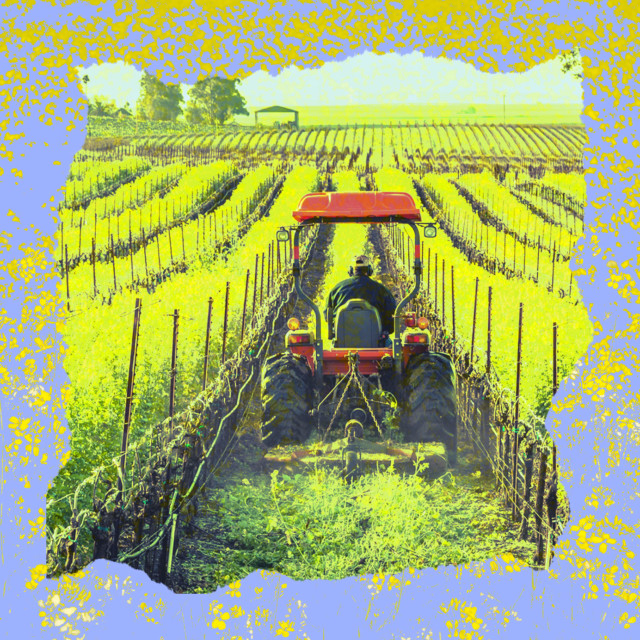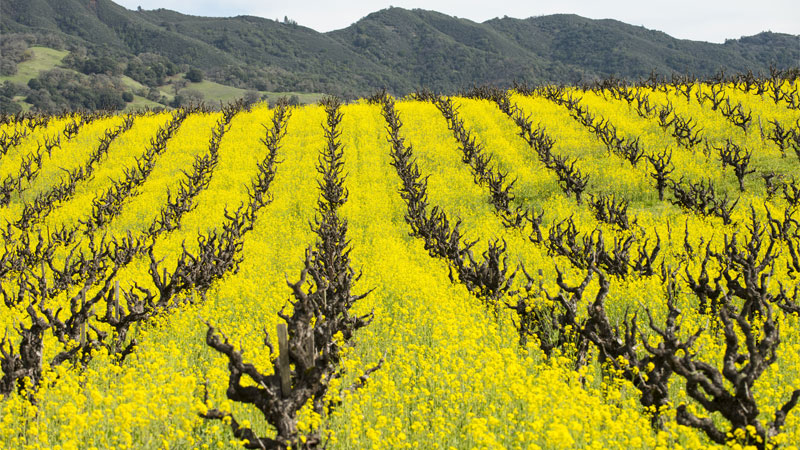Those familiar with sustainable agriculture have likely heard the term “cover crop” a few times before. According to SARE (Sustainable Agriculture and Research Education), cover crops are “plants that are used primarily to slow erosion, improve soil health, enhance water availability, smother weeds, help control pests and diseases, increase biodiversity, and bring a host of other benefits to [a] farm.” However, their use does not follow a one-size-fits-all model — and their benefits go far beyond what meets the eye. VinePair spoke with five winemakers around the globe to get the scoop on how cover crops are chosen, which factors are considered, and what their uses are beyond simple soil health.
Why Plant Cover Crops?
Lindsay Hoopes, proprietor of Hoopes Family Vineyard & Winery, explains that cover crops are one of the most important components of an organic and sustainable winegrowing practice. Additionally, Hoopes notes that cover crops are vital to promoting soil fertility, structure, and water-holding capacity, which improves soil nitrogen and microbes, as well as “regulates the disproportionate growth of any one plant organism.” In other words, cover crops prevent any one plant from taking over an entire ecosystem, which in turn, enables biological diversity in vineyards (basically, preventing a monoculture’s existence).
“Imagine if we were to eat only one food source or category — we would not receive all the necessary nutrients for our body,” says Hoopes. “Soil is living and actually functions, thrives in nutrient diversity in the same way that humans do.” Hoopes also points out that organic farming methods do not permit the use of synthetic soil nutrients. The solution? Cover crops.
Invigorating vs. Devigorating
But not all cover crops are created equal. Steve Matthiasson, owner and winemaker of Napa Valley’s Matthiasson Wines, explains that cover crop choices vary by soil condition and plant balance. “Grape variety plays into this, in that some varieties are more vigorous than others, and therefore tend to need either invigorating or devigorating,” he says. Matthiasson breaks cover crops down into three types: invigorating, those that provide erosion control, and devigorating. Matthiasson describes the industry standard “soil builder” (invigorating) as a blend of Cayuse oats (for organic matter), Triticale (for deep and fibrous roots), Magnus peas, and bell beans (for nitrogen). “This cover crop is good for turning around an abused vineyard, or getting young vines established,” he says.
For erosion control, Matthiasson explains that the most common cover crop is a 50/50 blend of Zorro fescue and Blando brome. “These are fast-germinating annual grasses with shallow but very fibrous root systems that are good at holding the soil in place,” he says, adding that this blend is used on flat grounds where eschewing tilling, namely for environmental reasons, is desired.
In terms of devigorating cover crops, perennial grasses (Chewings fescue, Creeping red fescue, and other various fescues) are common. “Perennial grasses are great for taming vigorous vineyards, which can hugely improve the wine,” he says, particularly noting that this blend is often used in Sauvignon Blanc vineyards in California. “By devigorating the vines, the perennial grasses can replace the pyrazines and cat pee [notes] with fruit and minerality, as well as improve the mid-palate and finish,” he says.
Diversity Is Key
In Austria, Fred Loimer works with a wide selection of crops, including clover, grain, flowers, and herbs. “Cover crops protect and feed the soil life, and soil life feeds the vines. For me, [using them] is an absolute must,” he says. Loimer notes that the selection of cover crops is based on soil, climate, and weather conditions, which will vary region to region.
In Argentina, Laura Catena, managing director of Bodega Catena Zapata and founder of Catena Institute of Wine, uses a blend similar to Loimer’s. “We tend to combine species from different botanical families: legume species like common vetch (Vicia sativa) attract flowers and provide nitrogen to the soil, while grasses like barley (Hordeum vulgare) and wheatgrass (Agropyron) have ‘hairy’ root systems that promote soil structure and avoid erosion,” she says. Catena also cites the use of Forb species (wildflowers), which extend their roots deep into the earth, and therefore aid with soil compaction and promote water infiltration. In addition to preventing runoff water and soil erosion, Catena notes that these cover crops provide organic matter to the soil, limit undesired weed growth, and promote biodiversity. “They also attract native pollinators and help in pest control by hosting some natural enemies of nematodes that attack our root systems,” she says.
Hoopes agrees that cover crops vary region by region — even more specifically from site to site within a region. “It is not the variety of grape that drives our cover crop decisions, but rather the soil composition, history, and surrounding environment of any given vineyard that informs the choice,” she says. For example, some of her vineyards are close to the river and are highly susceptible to nematodes, but not as problematic with respect to nutritive health or access to water. “[This is] because flood zones are usually surrounded by nutrient-rich clay and water, which sometimes can create too much vigor in the soil,” she says. In turn, the cover crops appropriate for these vineyards are therefore entirely different from the cover crops that would be suitable for hillside vineyards, which require much more consideration of erosion control.
“In our case, we need to pick cover crops that do not interfere with growing wine grapes,” Hoopes says. For her, this depends on the site, proximity to the river, and type of soil. Matthiasson builds on this idea. “Some cover crops use more water than others, so we can compensate for a dry or a wet location by which cover crop plants we use,” he says. If the spring is wet, Matthiasson notes that cover crops can be permitted to grow for a longer period of time (and therefore use more water) to compensate, whereas in a dry season, the crops can be cultivated or mowed down to save water for vine growth.
Are Cover Crops Necessary?
Not all winemakers view cover crops as completely necessary. Contrary to Loimer’s point of view, Chiara De Iulis Pepe of Abruzzo-based Emidio Pepe views cover crops as more of a tool than a necessary component to viticulture. “It’s not obligatory, not all vineyards need [them],” she says. That said, De Iulis Pepe finds that when well done, cover crops can create a solid balance in vineyards and help nourish their soils, as well as bring more pollinators and insects to the area.
“The idea of cover crops is that a few kilos of seeds can create tons of biomass,” she says. “You then decide what to do with everything that grows according to the needs of every specific plot.” For most winemakers, this looks like incorporating the green matter into the soil for a quick injection of organic matter, nitrogen, minerals, or folding it down to mulch as slow-release energy and protection against quick evaporation during warm and dry seasons. In Abruzzo, De Iulis Pepe uses leguminous plants for nitrogen, graminaceous plants to fasciculate root systems and bring structure to the soils, and cruciferous plants to purify soils. “Cover crops are particularly effective — and only really makes sense — when you plant many different species, as each one is able to bring different virtuous aspects to the soil,” she says, describing their effectiveness as “directly proportional” to a vineyard’s heterogeneity.
Additional Uses of Cover Crops
Of course, the benefits of cover crops go beyond vineyard polyculture and soil health benefits. Loimer reveals that his sheep benefit from extensive grazing after the season, and that insects, worms, and beetles also benefit from plant diversity and nutrient-rich soils. Catena also uses her cover crops to feed her animals (sheep, llamas, etc.), as well as her family, noting that some farmers will even sell their cover crops in addition to their grapes and wine.
Hoopes uses most of her cover crops for compost or culinary purposes, though some crops (mustard seeds) are simply harvested for decorative reasons. “It is fun to forage for fresh greens in the cover crops, the tips of the pea shoots are especially sweet and delicious,” says Matthiasson. De Iulis Pepe has also enjoyed the fruits of her cover crop labor. “We make incredible salads with them!” she explains.
In Pursuit of Balance
If there were any question of the value of cover crops, Hoopes wraps it up best. “In sum, cover crops are selected and planted between the vines to bring ‘life’ and nutrients back to the soil that are otherwise naturally depleted in the process of farming wine grapes (or any singular crop),” she says. Monocultures skew the ecological balance on a farm; cover crops prevent that while also bringing nutrients to the soils. “Soil feeds plants, and animals and plants in turn feed that soil,” Hoopes adds. “They work together to maintain ecological balance: What is depleted by growing one is regenerated by growing a different plant. This diversity is critical to maintaining soil and environmental health.” For Matthiasson, in addition to sustainability benefits, cover crops are one of the most important viticultural assets to balance vine vigor and, in turn, best translate terroir. Peas and salads are just the added bonus.

